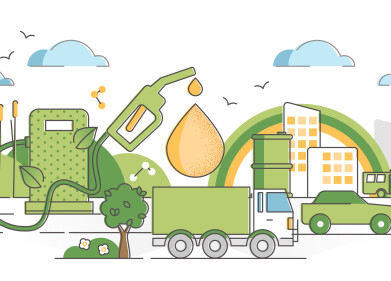Biofuel industry news
Can Ammonia Be Used as a Fuel?
May 25 2022
Over the past decade, rising global energy demands and an urgent need to address climate change have forced industries to explore alternatives to fossil fuels. Ammonia, a gaseous compound of nitrogen and hydrogen, has emerged as an exciting solution, with some analysts hailing it as the “fuel of the future”.
So, does ammonia deserve all the hype? Read on to find out more about ammonia and its potential as a fuel.
The pros of ammonia as a fuel
With an impressive energy density of 12.7 MJ/L, ammonia outperforms liquid hydrogen and is less flammable. Ammonia can also be stored at temperatures as high as -33 °C, unlike liquid hydrogen which must be stored at cryogenic temperatures of -253 °C.
“The advantages of ammonia are not only that it is a hydrogen carrier, but also its availability, amenability to storage and transport, and its utility as a fuel for various energy and industrial applications,” reads an article published in the journal Proceedings of the Combustion Institute. “The combustion of ammonia, which is the most effective way to use ammonia as an energy source, is a key technology.”
From agriculture to energy
In addition to its high energy density, ammonia is easy and affordable to produce thanks to existing infrastructure. The compound is a staple in the agriculture industry, where it’s used to produce nitrogen-rich fertilisers. Now, producers are looking beyond agriculture and exploring ammonia as a fuel source.
“Up to this point, we have made a business by selling the nitrogen value of the molecule,” says Tony Will, CEO of global ammonia manufacturing giant, CF Industries. “What’s really exciting about this is now there is an opportunity and a market that values the hydrogen portion of the molecule.”
Green ammonia
Ammonia has exciting potential as an alternative to fossil fuels, though its footprint isn’t entirely clean. Most ammonia producers use the Haber-Bosch process, which relies on pressurised hydrogen and atmospheric nitrogen. However, the hydrogen used is often derived from fossil fuels and has significant carbon dioxide emissions. Green ammonia addresses this issue by using hydrogen created by water electrolysis. Ammonia produced with this calibre of hydrogen is considered more eco-friendly than ammonia produced using fossil fuel derived hydrogen.
CF Industries is one of many companies set to invest heavily in green ammonia infrastructure over the coming years. The company plans to target the maritime industry though maintains ammonia will also step up as an alternative fuel for other hydrogen applications.
Blue ammonia
Green ammonia is gold standard but it’s not the only option available to climate-conscious producers. Blue ammonia, which is produced using carbon capture and storage solutions, is gaining momentum. It’s these types of innovations that will help establish ammonia as a fuel and promote it as a clean, eco-friendly energy source.
“In the 21st century, ammonia production using renewable energy can play a significant role in reducing GHG emissions and thus may contribute to mitigating climate change,” reads the Proceedings of the Combustion Institute article.
Want to know more about the latest energy innovations? Experts from Koehler Instrument Company explore the solutions being used to slash CO2 emissions and reduce dependence on non-renewable feedstocks such as coal, oil and natural gas in ‘State of the art of CO2-recycled fuels : a new frontier for alternative energy technologies’.
Digital Edition
PIN 25.6 Buyers' Guide
January 2025
Buyers' Guide Directory - Product Listings by Category - Suppliers Listings (A-Z) Articles Analytical Instrumentation - ASTM D7042: The Quantum Leap in Viscosity Testing Technology -...
View all digital editions
Events
SPE Hydraulic Fracturing Technology Conference and Exhibition
Feb 04 2025 The Woodlands, TX, USA
Feb 05 2025 Guangzhou, China
Trinidad and Tobago Energy Conference 2025
Feb 10 2025 Point Lisas, Trinidad
Feb 11 2025 Lagos, Nigeria
Feb 13 2025 Manama, Bahrain



















